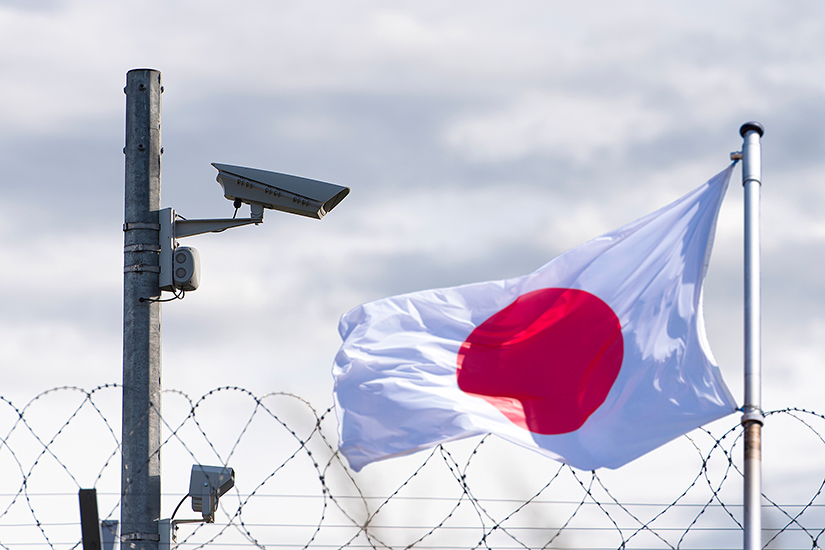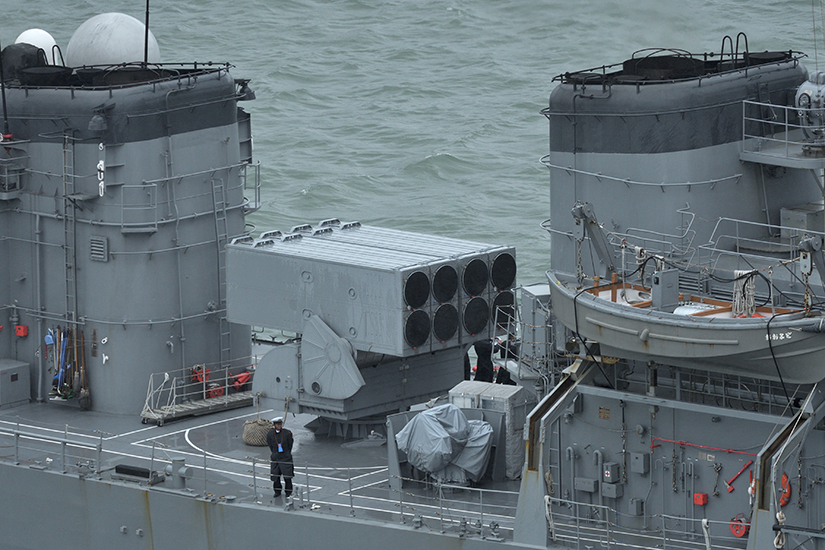Japan emerged from World War II with a new constitution, under which it abandoned even the right of self-defense—to say nothing of maintaining a standing army—with the expectation that the United Nations and the international community would provide for its defense.[1] However, as the Cold War rendered the UN dysfunctional and unable to provide protection, the restoration of sovereignty through peace forced Japan to rearm for its own defense. The constitution that renounces war, however, was never amended. The government responded to changes in circumstances by adjusting its interpretation to be consistent with the constitution each time. This began with the establishment of the Self-Defense Forces Law in 1954, and culminated in the development of the Peace and Security Law in 2015, which allowed the exercise of the right of collective self-defense, and idea that had been clearly denied in the past. Moreover, the National Security Strategy and the National Defense Strategy issued at the end of 2022 laid out the new policy of obtaining “counterstrike capabilities,” and the associated equipment, operations, and even a “Japan-U.S. Joint Operation Plan” are now under consideration.
Based on the above, this article will first summarize Japan's unique approach to the use of force in foreign territory and outline the history leading up to the possession of “counterattack capabilities.” After summarizing the relationship between armed conflict and international law, this report will attempt to examine the legal aspects of the possession of counterattack capabilities, focusing on collateral damage (CD) to civilians, civilian residents, and civilian property (hereafter referred to as “civilians, etc.”) that will inevitably occur in an attack, with reference to U.S. initiatives.

From “attacks on enemy bases” to “counterstrike capabilities”
As far back as February 1956, the government had already taken a position on the constitutionality of counterstrike capabilities in the form of missile attacks on enemy bases.[2]
To start, “attacks on enemy bases” are subject to debate vis-à-vis Article 9 of the constitution because of the prohibition on the use of force overseas by the Self-Defense Forces (SDF) in the supplementary resolution “Resolution Prohibiting (Self-Defense Forces) Overseas Deployment”[3] passed by the upper house of the Diet in June 1954, the month the Self-Defense Forces Law was passed. It was organized such that “attacks on enemy bases” are included in the scope of self-defense as an exception, rather “sitting and waiting for death,” as far as attacks like missile strikes are concerned.[4] However, until May 2019, the SDF did not possess such capabilities and it solely relied on the U.S. military to provide them.[5]
Japan's own missile defense capability against the growing threat of ballistic missiles and other missiles to Japan in recent years was initially planned to be improved through the introduction of Aegis Ashore in addition to the existing Aegis ships and land-based PAC-3s. However, the suspension of the introduction of Aegis Ashore made clear the limits of missile defense based solely on existing interceptor capabilities, and the need for new response measures has led to the possession of a counterattack capabilities as a part of Japan's own missile defense.[6] In this sense, “counterstrike capabilities” are constitutionally consistent with the government’s traditional constitutional interpretation of “attacks on enemy bases” in that they are exceptions to the prohibition of missile attacks on enemy territory. However, this kind of attack on enemy bases has been strongly criticized for fear that it will be used as for a “preemptive strike.” In light of the criticism, the ruling Liberal Democratic Party at an April 21, 2022 meeting of the Research Commission on Security recommended to the government that the name be changed to “counterstrike capabilities.”[7] The government’s security documents also respond explicitly to the criticism of preemptive strikes: The National Security Strategy says counterstrike capabilities apply “in cases where armed attack against Japan has occurred, and as part of that attack ballistic missiles and other means have been used,” and the National Defense Strategy says they “do not change Japan’s exclusively defense-oriented policy,” and “preemptive strikes, namely striking first at a stage when no armed attack has occurred, remain impermissible.”[8] Regarding the term “counterstrike capabilities,” former Defense Minister Itsunori Onodera, who chaired the LDP’s Research Commission on Security, told reporters,” Many people do not want Japan to launch a preemptive strike. The term 'counterstrike' is the most straightforward way to describe the use of the necessary capabilities to protect the country, and it can be easily understood by the public and people overseas.”[9]
Additionally, after Japan possess counterstrike capabilities, cooperation with the U.S. military, including accurate target information from reconnaissance satellites and the suppression of enemy air defense systems, is essential. As a result, the two documents mentioned above both state that Japan and the U.S. will cooperate in dealing with counterstrikes.

Armed conflict and international law
International law governing armed conflict (the Law of Armed Conflict)[10] is a very specific system that recognizes the right of belligerents to kill or wound combatants and destroy military targets in armed conflict, while allowing collateral civilian and other damage as long as it is within certain limits. This system can be viewed as the second-best option to minimize the damage of armed conflict, as the reality is that such conflicts would not stop even if they were officially prohibited.
In this context, the 1977 Additional Protocol to the Geneva Conventions I (hereafter AP I), after stating that “the right of the Parties to the conflict to choose methods or means of warfare is not unlimited” (Article 35-1), provides for the protection of civilians and others in Part IV (Articles 48-56). It includes regulation on the conduct of combat, including the principle of distinguishing between military and civilian populations and objectives (Article 48), as well as the prohibition of indiscriminate attacks that do not differentiate between civilian and military targets (Article 51-4). However, regarding the CD that results from attacks on military targets, AP I only acknowledges the “Principle of Proportionality,” which prohibits indiscriminate attacks “which may be expected to cause incidental loss of civilian life … which would be excessive in relation to the … military advantage anticipated” (Article 51-4[b]).
The law of armed conflict is said to strike a balance between military necessity, which seeks to achieve victory by killing or wounding enemy combatants or destroying military objectives, and humanitarian consideration, which seeks to protect civilians and others. However, even if one speaks of balance, these two ideas stem from entirely different perspectives, and it is a massive contradiction to compare them. Therefore, due to the generality and abstract nature of AP I, which does not provide clear criteria for the relevant provisions, interpretive disputes can arise over the specific application of the provisions.
With this lack of clarity in how to ensure humanitarian considerations, the U.S., which has long experienced operational obstacles in the form of intense criticism from international humanitarian groups and the mass media for excessive CD, has been working for some time to develop specific standards to reduce CD. The initiative is called the Collateral Damage Estimation Methodology (CDM), and it establishes specific procedures to mitigate CD in the planning process of joint operations. It was issued by the Chairman of the Joint Chiefs of Staff in 2002 and revised in 2005, 2007, 2009, and 2012.[11] The calculation method requires the input of parameters into a computer to estimate the CD resulting from an attack on a set target, and the consideration of means and methods of attack to mitigate such damage. When the potential for CD becomes excessive for Level 1, the lowest level, the system moves to the next level, up to Level 5. When an attack reaches Level 5, the highest level, the secretary of defense or the president is supposed to authorize the attack.[12] CDM has also been employed in ISAF operations in Afghanistan and has been credited with a significant reduction in civilian casualties since 2008.[13]

New issues for Japan
AP I obligates belligerents to prevent CD in Part 5, which follows the protection of civilians discussed in Part 4. Specifically, Article 57 and Article 58 stipulate the obligations of the attacker and the party being attacked, respectively.
To protect civilians and others in armed attack situations, Japan developed the Armed Attack Situation Countermeasures Law in 2003, followed by the National Protection Law in 2004. However, all of these were exclusively directed toward the “protection of the people” within Japanese territory, and there was no need to consider CD in an attack on an enemy nation. With regards to the obligations of AP I, Japan has addressed only those stipulated in Article 58. But with the new move to acquire counterstrike capabilities, which entails the possibility of attacking enemy territory, Japan is now also subject to the obligations of an attacker as listed in Article 57.
On this, a different perspective from that of conventional unit operations, equipment, tactics, and so on, will be required in the consideration of whether Japan should construct its own CD mitigation measures, or whether Japan and the U.S. should adopt the U.S. CDM as it is as a joint Japan-U.S. effort, or whether it should be left to Japan-U.S. coordination on a case-by-case basis.
Incidentally, the Joint Targeting School in the U.S. offers a week-long CDM training course[14] for 30 students (about 40 hours), the NATO School offers a training course[15] on U.S. CDM, and the Canadian Army Command and Staff College also offers a CDM training course[16], each of which qualifies graduates to become CDM analysts. Training and enrollment in such courses should also be considered.
(2023/04/13)
Notes
- 1 At a plenary session of the House of Representatives of the Imperial Diet on June 26, 1946, Prime Minister Shigeru Yoshida said, “I renounce both war as an exercise of the right of self-defense and the right of belligerency,” and further stated, “I renounce first and foremost the right of belligerency under any name” (author’s emphasis). He renounced not only war in the name of self-defense, but also the right to self-defense (the right of belligerency). Official Gazette Extra, Stenographic Record of Proceedings of the House of Representatives, 90th Session of the Imperial Diet, No. 6, p. 82. June 27, 1946.
- 2 Substitute reading of the prime minister's reply by Defense Agency Director Naka Funada. Minutes of the 24th Diet Session, House of Representatives, Committee on the Cabinet, No. 15, p. 1. February 29, 1956.
- 3 After the law was adopted, a supplementary resolution was passed that effectively prohibited the use of force by the SDF in foreign territory. The resolution itself is not legally binding, but successive governments have said they will respect and abide by it. Resolution of the Plenary Session of the 19th Diet Session, House of Councillors. June 2, 1954.
- 4 Minutes of the 24th Diet Session, House of Representatives, Committee on the Cabinet, No. 15, p. 1. February 29, 1956.
- 5 At a plenary session of the House of Representatives on May 16, 2019, Prime Minister Shinzo Abe said, “Even under the new NDPG and Mid-Term Defense Plan, the government does not intend to develop an equipment system for so-called enemy base strikes. Regarding so-called enemy base strikes, Japan and the U.S. depend on U.S. strike capability in the division of roles between the two countries, and the government does not intend to change this basic division of roles in the future as well.” Official Gazette Extra, Stenographic Record of Proceedings of the House of Representatives, 198th Session of the National Diet, No. 24, p. 8. May 16, 2019.
- 6 On September 11, 2020, then Prime Minister Abe mentioned the limits of defense based solely on interceptor capability in his statement regarding the replacement of Aegis Ashore, marking the beginning of the concrete steps to acquire counterstrike capabilities. Prime Minister's Office, “Prime Minister's Statement,” September 11, 2020;
Yoshifumi Takemoto, “Prime Minister Abe Speaks on Enemy Base Attack Capability, Urges Discussion in Next Government,” Reuters, September 11, 2020. (Japanese). - 7 “Self-Defense Forces Proposal to Rename ‘Enemy Base Attack Capability’ to ‘Counterstrike Capability,’” NHK, “News Web,” April 21, 2022. (Japanese).
- 8 National Security Council Decision, Cabinet Decision, “On the National Security Strategy,” December 16, 2022;
National Security Council Decision, Cabinet Decision, “On the National Defense Strategy,” December 16, 2022. - 9 See Note 6.
- 10 In general, the “Law of Armed Conflict” is also referred to as the “Law of War (International Law of War),” and, especially since the rise of humanitarian awareness in the 1970s, it is often called “International Humanitarian Law.” These are all considered synonymous. International Committee of the Red Cross (ICRC), International Humanitarian Law - Answers to your Questions, December 2014, p. 5.
- 11 Chairman of the Joint Chiefs of Staff Instruction, “No-Strike and the Collateral Damage Estimation Methodology; CJCSI 3160.01A,” October 12, 2012.
- 12 For more on CDM, see “(U//FOUO) Joint Chiefs of Staff Instruction: No-Strike and the Collateral Damage Estimation Methodology,” U.S. Joint Chiefs of Staff, Public Intelligence, November 15, 2013.
The U.S. military uses the abbreviation “CDM” instead of “CDEM.” A detailed analysis of CDM based on examples of CD in NATO and ISAF operations in the former Yugoslavia and Afghanistan is contained in “Humanizing Means of Attack in Armed Conflict - Possible Clarification on the Interpretation of Article 57 (Precautions in attack) of Additional Protocol I” (Japanese) by Yusuke Ichimaru, to be published in the Maritime Self-Defense Force Command and Staff College journal, Japan Maritime Self-Defense Force Command and Staff College Review (Japanese). - 13 Ichimaru, ibid.
- 14 U.S. Joint Targeting School, Collateral Damage Estimation Qualification Course Syllabus, 2021.
- 15 “N3-97: Collateral Damage Estimation Methodology,” NATO School, Course Catalogue.
- 16 Canada offers a Basic Course and an Advanced Course of 5 days each. The Advanced Course is open only to those who have completed the Basic Course, and certification is granted to those who have completed the Advanced Course. Major-General C. Vokes, “Basic Collateral Damage Estimation Course (BCDEC),” Canadian Army Command and Staff College, Joint Instructions annex F-ACDEC, October 15, 2021.

